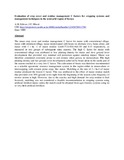| dc.contributor.author | A.M, Kilewe | |
| dc.contributor.author | J.P, Mbuvi | |
| dc.date.accessioned | 2013-02-26T11:17:28Z | |
| dc.date.issued | 1989 | |
| dc.identifier.citation | Kenya lournal of Sciences Series B (1989) 10(1-2): 75-82 | en |
| dc.identifier.uri | http://erepository.uonbi.ac.ke:8080/xmlui/handle/123456789/11790 | |
| dc.description.abstract | The mean crop cover and residue management C factor for maize with conventional tillage, maize with minimum tillage, maize intercropped with beans on alternate rows, beans alone, and maize with 3 t ha -1 of maize residue were0.77,0.45,0.44,0.3O and 0.15 respectively, as measured in two groups of subsequent rainy seasons. The high C factor for maize with conventional tillage was aitributed to low planting density for maize and slow groundlover development that provided very minimal soil protection against raindrop impact. Maize was therefore considered extremely prone to soil erosion when grown, in monoculture. The high planting density and fast ground cover development achieved by beans alone in the eaily part of the season resulted in a very low C factor. The cultivation of beans was therefore recommended as a suitable agronomic resource rnanagement system in this region either in monoculture or intercropping with erosion prone crops like maize. Mulching at the rate of 3 t ha-I of maize residue produced the lowest C factor. This was attributed to the effect of maize residue mulch that provided over 50% ground cover right from the beginning of the season rylen frequency of erosive storms is high. However, due to the scarcity and high demand for crop residue to feed livestock, mulching was not considered a feasible recommendation in cropping systems using artificial fertiliser inputs
unless the mulch could be obtained from agroforestry systems using no or very little artificial fertiliser. | en |
| dc.language.iso | en | en |
| dc.subject | Crop cover | en |
| dc.subject | Residue management | en |
| dc.subject | Cropping systems | en |
| dc.subject | Semi-arid region of Kenya | en |
| dc.title | Evaluation of crop cover and residue management C factors for cropping systems and management techniquesin the semi-arid region of Kenya | en |
| dc.type | Article | en |
| local.publisher | Kenya Agricultural Research Institute | en |
| local.publisher | Department Of Land Resource Management and Agricultural Technology, University of Nairobi | en |

